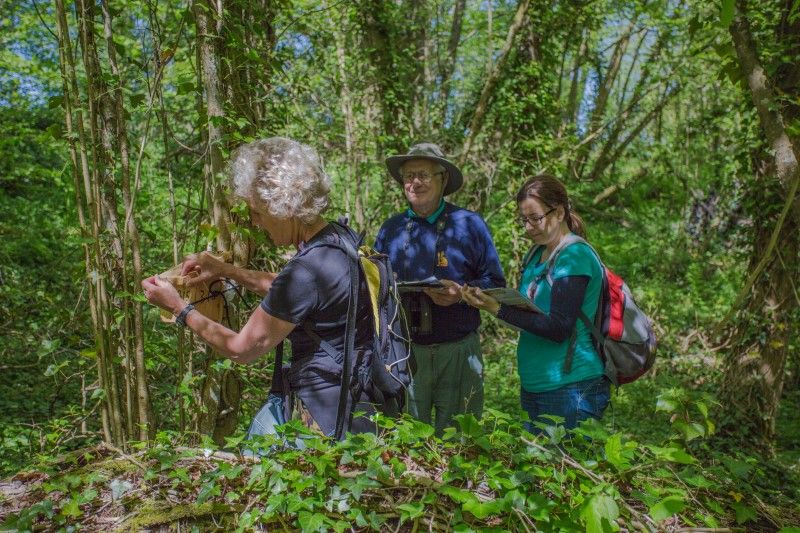Celia Carter has been monitoring dormice in Marden Park, a large area of Woodland Trust land, on North Downs in Woldingham, Surrey since 2005. She tells us how What3Words (W3W) has made searching for dormouse boxes, and hopefully dormice, easier.
Searching for dormouse nest boxes
The woodland here is dense and in summer there’s quite a lot of undergrowth which can make finding nest boxes tricky. Trees fall every winter, sometimes obscuring the boxes, and throughout summer the vegetation changes rapidly, making finding boxes even more difficult. When I can’t make one of the survey dates, or when we set up a new site, we’re faced with the same difficulties of hunting for the nest boxes once again.
I’ve tried several methods of recording and mapping the boxes over the years. Initially, I produced hand drawn maps which were little better than guesses and not very helpful to others trying to use them. In 2013, with help from an ecological consultant, we recorded GPS positions for each box. Unfortunately, it was often quicker to search for a box than to wait for a GPS signal! And then the ecologist moved away, leaving me without the technology.
Then I tried using compass positions. These were taken with my back to a box while facing the direction of the next box and then recording the approximate number of paces between each one. This method worked but it proved just as time consuming as searching for the box with no help.
Navigating woodland using What3Words
Then I discovered What3Words. It seemed like a good solution for mapping nest boxes, and in 2019 I recorded the three-word locations for each nest box at my site. Initial efforts weren’t promising. The cursor was only visible intermittently – which I wrongly attributed to leaf cover. The W3W word combinations for each box seemed to change every time they were taken, and it was difficult to download the maps.
But we persevered and in 2021, when we put 50 new boxes up at a second site in Marden Park, we recorded the W3W locations. After initial teething problems and several trials, the system seemed to work. In July 2022, I was delighted when a licence holder who hadn’t visited our site before was able to navigate the woods and successfully find boxes much quicker than using the old hand drawn map.
If you’d like to try this method on your site, here are a few hints which may help. If you’re not familiar with W3W, getting to know its basic functions should make these hints easier to follow.
Making your What3Words map
- In the menu open a new LOCATION and add site name. Then open that location.
- At the first box position take a W3W reading.
Hint: If you take the reading more than once at a box it may well give a different three words. This ultimately is not a problem when re-finding a box as any of the readings will take you within visual distance. However, to make it more accurate, stand with your back as close as possible to the front of the box when taking its reading. Hint: If you switch off your phone then restart recording, check you are using the correct site location map, as W3W puts records into ‘Favourites’ by default. You can move records from ‘Favourites’ to the correct location map, but it takes time. - On W3W, TITLE the box with its number (and if needed add any notes) and press SAVE.
- When all the boxes are recorded open the map function and check it is showing the correct number of boxes. The number of boxes will also show next to your site’s name in your W3W contents list.
Hint: If not all boxes show on your map, check in the ‘List of records’ for any you recorded but forgot to save and save them. If the number of boxes is still incorrect, check no records have ended up in ‘Favourites’ and if so move them.
Using your map to find dormouse nest boxes
- Open your site location, click map and click on the first box. A circular icon with a cross in will then appear. Click that icon and a dot will appear. This dot is the cursor which shows you where on the map you are currently standing.
- Start walking towards your first box. The cursor will move with you so you can see if you need to change your direction.
Hint: If the cursor stalls or pauses just re click the cursor icon and it will restart and reposition. - Following the cursor towards the box will enable it to be spotted.
Hint: If, rarely, the cursor gets to the box on the map, but you have not yet seen it, find the box and retake its W3W reading. Remember to delete the original inaccurate box reading. - You can share your W3W map with other monitors by email which is extremely useful when you cannot attend a survey or are handing over a site.
I hope this information is helpful to anyone who has difficulty finding their nest boxes and, if you try it, please let me know whether it works for you. (email ndmp@ptes.org)
Written by Celia Carter

